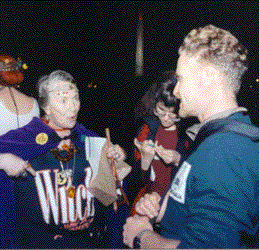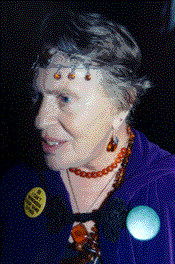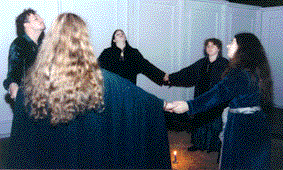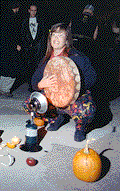Greenbelt Interfaith
News
Washington Feature
![]()
November 1997

High Priestess Rosemary Kooiman shows off her sweatshirt to Dave Holm, an Odinist.
A Merry Meet in D.C.
America's Pagans Gather in the Nation's Capital
By Heather Elizabeth Peterson
Photographs by John Wallin
Greenbelt Interfaith News
Eight p.m. at the Jefferson Memorial in Washington, D.C. At the memorial itself, intrepid tourists were taking a late-night look at the classical structure that pays tribute to the author of America's Declaration of Independence. At the bottom of the memorial's steps, next to a tidal pool dark with the reflection of clouded skies, a group of men and women sat in a circle, listening to the beating of a dozen drums. Standing nearby, two women were determining a matter of great importance.
"Where is the east?" asked one.
The second woman, dressed in the amber jewelry that showed her rank as high priestess, pointed unerringly toward a line of trees. "That way," said the Rev. Rosemary Kooiman of Lanham, Maryland. "The Lady always rises over there. I don't know whether we'll see her tonight, though; it's so cloudy."
"Well, it's the new moon," said the first woman without hesitation.
This was undoubtedly the best place in Washington to learn the moon's location and phases, for here, at the Nation's Capitol, Pagans from across America had gathered together. Blessed Be and Meet Me in D.C. was the cheery name of their gathering, making reference to the two manners in which Pagans greet each other. Their greeting was also extended to outsiders, for through this gathering they wished to let the world know that people had nothing to fear from witches and druids and other Pagans – even on this night, Halloween.
For Pagans this was a religious holiday, the eve of Samhain, which marks the beginning of the Pagan New Year. For many Christians, the echoes of this Celtic holy day can be found in All Saints' Day on November 1 and All Souls' Day on November 2, two Christian holy days that memorialize the dead. To many Pagans, these Christian holy days in turn are an echo of an older time: the time when the Christian Church, in a determined effort to eliminate Paganism, replaced Europe's older holy days with its own.
The memory of these times sting for modern Pagans: they are called the Burning Times, a reference to the Christian practice of burning witches. Even today, Pagans say, members of their faith face misunderstandings and discrimination. For this reason, U.S. Pagans had chosen to meet in Washington, the symbol of America's freedom, including the right to worship.
Of course, prejudice can always be fought with humor. As the opening ceremony began and a plane roared overhead, Ms. Kooiman said, "If anyone ever tells you that the pentacle [a witch's symbol] is evil, tell them to look under the wings of an Air Force plane." She added with dark humor, "Every single plane of the armed forces is ours."
PERSECUTION AND CRITICISM
It was the sort of jest that could only be made among fellow Pagans, for in other places, the joke might be believed. Pagans have so great a fear of being misjudged and persecuted that some at the gathering did not wish to be photographed or to give journalists their last names or hometowns. They were not "out" to the rest of the world.
Evidence that this fear of persecution is not simple paranoia may be found at a Web site called Perilous Times, which recently posted a "Witches in DC Notice" about the upcoming gathering. "These people work 365 days a year to destroy America and corrupt our youth for the devil and Halloween will be their 'all out' day in Washington DC," said Tammy Ritchie, editor of the page. "I want Christians to pray about this and pray that the rituals that will be done at this 'march' in front of the Jefferson Memorial will not adversely affect America. We have enough problems. We don't need witch curses too."

All that can be said about such wild accusations is that they reflect a surprisingly widespread view that sometimes makes its way into the media. Thus Pagans spend a great deal of time explaining elementary facts about their faith: No, they do not worship the devil. No, they do not sacrifice humans or animals. No, they do not proselytize – new members usually seek out Pagan groups rather than the other way around. And yes, they do have a unified purpose: most Pagans adhere to the Wiccan Rede, which says, "An ye harm none, do what ye will."
Paganism, though, also faces attack from more knowledgeable critics: critics who do not confuse Paganism with Satanism, critics who have taken a hard and sometimes sympathetic look at the Pagan movement and do not like what they see.
Some critics attack Paganism on the grounds that it is logically inconsistent. Craig S. Hunter, author of Witchcraft: Exploring the World of Wicca, dispassionately describes the Wiccan worldview in an article for the conservative Christian Research Journal before he asks the questions that bother him: "(1) Where does the Wiccan Rede derive from? (2) If there is 'no one right religion, way, or truth for all,' then why is this rule (the Wiccan Rede) universal? How do we know that witches are not just trying to impose their rule on us to 'shackle our minds and actions'? (3) How do witches account for the origin and existence of evil and suffering?"
Other critics condemn modern Paganism on the grounds that it has no relation to the ancient Earth-centered religions. A 1995 editorial in the Washington Times Weekly complained, ""What is weird [about the modern Pagan movement] is that, whatever the good intentions or seriousness of its adherents, it's basically a fake. It's a fake because, despite the respectably ancient lineage of paganism, real and authentic paganism died out in the Western world centuries ago, and its present-day devotees are drawn to a modern, feel-good, jerry-rigged version that no self-respecting ancient pagan, rock-worshipper, or philosopher ever practiced."
These are real questions that Pagans must address, and sometimes do address. Perhaps the hardest criticism for Paganism to avoid is that it is a feel-good faith, allowing its members to do anything they want, as long as their actions do not harm others. Does such a faith add any good to the world? Has the religion that was once based on sacrifices to the gods and goddesses become nothing more than a tool for self-fulfillment?
IN SEARCH OF THE GODS
Down at the edge of the tidal pool, everyone had grown still. Isaac Bonewits, a prominent Pagan, was leading the night's blessing. " Feel your feet putting roots down through the concrete, down through the cracks, into our holy Mother Earth," said Mr. Bonewits. "Become a tree rooted in the ground, growing on the surface of the Mother. Let your body and your spirit and your aura be filled with her strength and her love."
The blessing was followed by a song: "It's the blood of the ancients that runs through our veins/ And the forms pass, but the circle of life remains." People began calling out the names of the dead, both private and public, "Benjamin Franklin . . . Jim Henson . . ." Mr. Bonewits reminded the crowd that one name was especially important. "We stand here at the memorial for the one person who is responsible for us having the religious freedom to stand here," he said.
The solemnities ended, the quiet songs were replaced by drumming, and many of the Pagans began dancing around the sacred circle they had formed. Others stood on the steps, chatting with friends and strangers.
Dave Holm, a soldier from Virginia, watched the dancers with delight. "Most of the world doesn't know about Paganism," he said, "and most of what they believe is that we're devil worshippers."
He wore a badge with his Internet name, RoseWarlok, a name he immediately defended. "Lots of Pagans don't like my name because they think of warlocks as oath-breakers," he said. "In my path, a warlock is a protector."
His religion and his work are intimately connected: Mr. Holm hopes some day to become the U.S. army's first Pagan chaplain. Several Wiccan chaplains already exist, but Mr. Holm is not a Wiccan. Despite the public's perception that all Pagans are witches (or Wiccans, as modern witches call themselves), there are many varieties of Paganism. As Mr. Holm's army dog tags reveal, he is an Odinist: he worships the Norse gods, who are warriors. Mr. Holm says that he stumbled by accident upon "one of the least favorite" forms of Paganism.
"I was a seeker for many years," he said, "not knowing what I was looking for, but seeking it." During a visit to Norway, he learned about the Norse myths and soon afterwards became a Pagan. He ticks off rapidly the qualities he admires in Odinism: "There's no evil – the worst that the gods do is mischief. There's no absolute evil and absolute good. You can be strong in yourself – if someone hurts you, hurt them back. Family ties are important."
He has fulfilled this final Odinist qualification with a flourish. Last December, he met LtEyeWolf in a chat room – Shawna was her real name. They talked by the Internet almost nonstop for seven days. "Ninety-eight hours," said Mr. Holm. "That's more talking than is done by most couples who date." On the seventh day, Mr. Holm went to meet his chat partner. "I asked her to marry me," he said.
"Two hours later," Ms. Holm interjected.
"And she said yes—"
"Two seconds later."
Mr. Holm's officer, suspicious of this whirlwind romance, required that the couple meet with the army chaplain, who turned out to be a Catholic priest who knew nothing about Paganism. The chaplain sent a note to the officer saying that the couple should not marry under any circumstances. Despite this fact, the couple were married in a civil ceremony twelve days after they met in cyberspace. Last June, they were joined in a handfasting, a Pagan marriage ceremony.
Ms. Holm became Pagan after she learned about Wicca at age 14 when writing a school report on witchcraft. Mr. Holm commented that public school students learn a lot about Paganism, what with lessons on mythology and classical civilization and holidays such as Halloween – in fact, he believes that public school students should be taught more Christian history.
As for Ms. Holm, she became an Eclectic Pagan, drawing upon the different Pagan traditions of her Irish, German, and Native American heritages. She lived in a small town, though, and did not know anyone else who was Pagan; she did not even tell her mother about her faith until the day before her wedding. She attended the Catholic college in town, and as a freshman she took a course in comparative religion from a monk. On the first day of class, he ran down a list of religions, asking the students to raise their hands if they belonged to that religion. Ms. Holm was the only one not to raise her hand. Afterwards the teacher took her aside. "Well, what religion are you?" he asked. Ms. Holm ended up giving talks on Paganism to each of his classes.
She finally met her first Pagan in college: "I was walking past him one day, and there was something about him that made me say, ‘Merry meet,' and he immediately replied, ‘Blessed be.' And I thought, ‘Oh, cool, another one of us!'"
![]()

Left to right, Peter, Diana, Dawn, Deirdre, and Ford invoke the gods and goddesses.
PAGAN SACRIFICES
This was a sentiment echoed several times during the evening as hundreds of Pagans drifted in and out of the gathering. Nobody knows how many Pagans live in the United States – estimates range from 5,000 to over 100,000 – but it is still such a small faith that distances can be lengthy between one member of a coven (a Pagan church) and another.
Off at the edge of the D.C. gathering stood a group of five pagans, members of a coven that covers three states. The coven (which does not yet have a name) is located in Rhode Island, Massachusetts, and New Jersey, and its members communicate mainly through the Internet. Even their meetings for ritual are a makeshift affair.
"This is our circle." Deirdre, a psychiatrist, pointed to the sacred circle the coven had formed. "Sometimes it's more an oval than a circle. It depends on how far back we can push the furniture."
In the middle of the circle flickered candles; more candles marked the quarters of north (representing earth, strength), east (air, inspiration), south (fire, constancy), and west (water, compassion).
The coven has no leader, although the members are able to draw upon the expertise of Peter, who is an archaeologist, and Ford, who researches the Celtic world. "We try to find out what was done then so that we can do it now," she said.
So do modern Pagans make any sort of sacrifice to the gods? Or is the religion essentially self-indulgent?
"Being identified as a Pagan is a sacrifice in itself," said Peter immediately.
Diana agreed; she had revealed herself to be a Pagan while she was an English major living in a college dormitory. "I could have come out as a screaming lesbian and the other students would have coped with it better," she said.
"Your sacrifice is to live your life the way the gods would want you to," Ford said. "The sacrifice I would make for my religion would be to make myself be whole and healthy."
"The sacrifice is: use your gifts even if it hurts you," said Deirdre.
Each of the coven members was drawn to Paganism in different ways. Dawn, an artist, had strange dreams that she finally identified as Pagan. Deirdre's family is Catholic; dissatisfied with Christianity, Deirdre tried without success to convince herself that no spiritual power exists. Diana's parents are atheists, and she was brought up to believe that religion is a tool for controlling the masses. "I wanted religion as a child," she said. "I'm a rationalist, but I believe there is power and force in the world."
Some Pagans believe that the gods and goddesses are symbolic; others believe that the many deities are manifestations of a single spiritual power present within nature; still others believe that there are many more gods and goddesses than anyone knows. This lack of cohesiveness in Pagan theology does not disturb the coven members, who see Paganism as a unified community. "Family is very important," said Diana. "Few people are brought up as Pagans, so it's important for us to be part of a community and stand up to be counted."
As for the charge that Paganism is a modern invention – well, so what? remarked Diana. "Perhaps I cannot sacrifice a white bull to Mithras," she said, "but I have brought goldfish crackers here to sacrifice in place of goldfish." And she pointed to the bag at her feet.
UNITY OF PURPOSE
Witches don't like water.
That is what an outsider might have concluded the next afternoon while looking down from the rain-slick steps of the Lincoln Memorial. A nearby druid looked at the group around him. "I don't see a thousand druids," he said. "I don't see a thousand Pagans. But here we are, to the amusement of the park police."
Standing in a circle under the drizzling rain, a dozen Pagans raised their voices in song:
Rising to the heavens,
We all come from the Sun God,
And to him we shall return
Like a spark of flame.
The rain slowly stopped; triumphantly, the Pagans finished their song. Wrenmare, one of the organizers of the event, tearfully looked at the tiny crowd, saying, "I can't believe this has happened."
 The
rest of the Pagans were more cheerful. They patiently formed the eight
sacred circles they had planned, even though there were not enough people
present to keep the circles going once they had been formed. They cheerfully
wove ribbons around their maypole (ignoring the fact that May Day, the
Celtic holy day of Beltane, was half a year ahead), then sat around and
talked. Some Pagans wandered over to the Lincoln Memorial, where once the
Rev. Martin Luther King Jr. had spoken burning words on freedom and justice.
Other Pagans thanked the gods (and goddesses) that Christian fundamentalists
had not turned out in force, as they had feared would happen.
The
rest of the Pagans were more cheerful. They patiently formed the eight
sacred circles they had planned, even though there were not enough people
present to keep the circles going once they had been formed. They cheerfully
wove ribbons around their maypole (ignoring the fact that May Day, the
Celtic holy day of Beltane, was half a year ahead), then sat around and
talked. Some Pagans wandered over to the Lincoln Memorial, where once the
Rev. Martin Luther King Jr. had spoken burning words on freedom and justice.
Other Pagans thanked the gods (and goddesses) that Christian fundamentalists
had not turned out in force, as they had feared would happen.
Suddenly, a song cut through the chatter.
"Oh, no," said Shawna Holm. "We knew that the Satanists would turn up."
Skipping his way down the sidewalk near the Lincoln Memorial's reflecting pool, a man in a red cape, with cloth horns tied to his head, made his way toward the gathering as the Pagans watched in silence. "What the Satanists don't understand is that they're Christians," said Ms. Holm. "Satan is a Christian deity." She turned to the woman beside her. "We've got to get a chant going," she said.
The women scurried away. The man in the red cape had now reached the top of the steps on which the Pagans were gathered. Near him was the altar that the Pagans had erected, along with bins holding food donated for homeless shelters. Further down the steps were flowers that had been given by the Pagans, and that were scheduled to be donated to hospitals later that day. The man twirled around, singing parodies of Christian hymns, and the Pagans began to giggle.
"See?" said Dave Holm. "We don't worship with them; we laugh at them." He hurried away to join the forming circle.
Singing loudly in order to drown out the sound of the visitor, the Pagans held hands; nearly a hundred of them now stood on the steps.
Rising to the heavens,
We all come from the Sun God,
And to him we shall return
Like a spark of flame.
Flowing to the ocean,
We all come from the Goddess,
And to her we shall return
Like a drop of rain.
A patch of blue appeared in the overcast sky; the man in the cape, now ignored, wandered away. The singing grew louder as one Pagan met another in the center of the circle, and they twirled around together. The first Pagan rejoined the circle while the second Pagan chose a new partner; then the second Pagan in turn retired while the third Pagan found a partner; and so the chain of dancing continued as the Pagans sang:
May the circle be open but unbroken,
May the peace of the Goddess be ever in your heart.
Merry meet and merry part
And merry meet again.
![]() Related
Links
Related
Links
"The Modern World of Witchcraft," by Craig S. Hawkins: Part One, Part Two (1990-91)
Paganism in the Modern World, by Elizabeth Barrette
![]() Next
Page
Next
Page
Blessing on Samhain at the Jefferson Memorial. By Isaac Bonewits.
![]()
Text © 1997 Heather
Elizabeth Peterson
Photographs © 1997 John Wallin
Readers wishing to publish or post copyrighted material from this
magazine must contact Greenbelt Interfaith News for permission (faith@greenbelt.com).